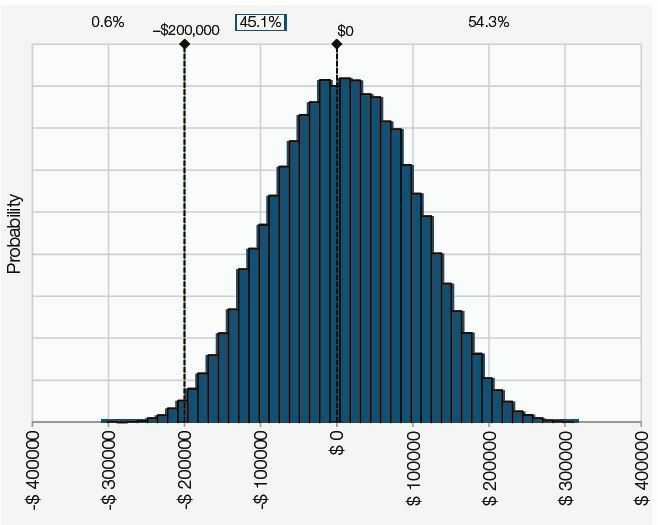The results above were derived using a simple economic model. It is relatively easy to increase the sophistication of the model to consider a wide range of ‘what if' questions about project viability and risk. One way to increase the sophistication of the modelling is to undertake systematic risk analysis using the underlying model framework.
This involves systematically varying all of the input assumptions (ACCU price, costs and so on) a large number of times, and recording the results for each simulation. The output is a series of values for net benefits that provides an indication of the likelihood of a particular outcome.
It can be used to judge, for example, the probability of a particular outcome, such as a positive net project value.
Table 10.5 summarises the input assumptions for an illustrative risk analysis of this kind. The assumptions in the table illustrate scenarios that are typically constructed using systematic risk analysis. ACCU prices are assumed to vary randomly between $5 and $30 (with an equal likelihood of any value in between).
Because ACCU prices are highly uncertain, this is a systematic approach to testing different price outcomes. Private co-benefits are also uncertain. For the systematic risk analysis presented here, it is assumed that there is an 80% chance that any of these benefits will emerge in any given year.
For public co-benefits, 20% is assumed. Cost elements are assumed to fall randomly (using a uniform probability distribution) along the ranges set out above.
|
|
Table 10.5: Assumptions underlying simulated risk analysis |
|
|
|
|
Variable |
Assumption |
|
|
|
ACCU prices |
Equal likelihood of prices between $5 and $30 |
|
|
|
Private co-benefits |
80% chance of capturing private benefits (as per Table 8.7) |
|
|
|
Public co-benefits |
20% chance of capturing public benefits (as per Table 8.7) |
|
|
|
Opportunity cost of land |
Equal likelihood of values between $0 and $1500 per hectare |
|
|
|
Project establishment
|
Equal likelihood of costs between $800 and $3000 per hectare (as per Table 9.2) |
|
|
|
Maintenance costs |
Equal likelihood of cost between $5 and $67 per hectare (as per Table 9.2) |
|
|
|
Fire, disease or other
|
1% chance of loss of carbon stock (requiring reestablishment) in each year from Year 25 to Year 50 |
|
Source: CIE calculations.
Figures 10.1 and 10.2 summarise the probability distribution of outcomes for net benefits, including all benefits (Figure 10.1) and ACCU revenue only benefits (Figure 10.2).
Figure 10.1 indicates that, under the specified assumptions, there is a wide range of possible net benefits when all benefits (ACCU revenue and co-benefits) are taken into account. The chart suggests that there is a 54.3% chance of net benefits greater than zero, and a 45.1% chance of a net loss of up to $200 000.
There is a 0.6% chance of a net loss greater than $200 000. The interpretation of these outcomes depends on the preferences and risk profile of the farm enterprise.
Figure 10.1: Probability distribution of project net benefits: all benefits |
|
|
Data source: CIE simulations.
Figure 10.2 shows results when only ACCU revenues are counted in benefits. In this case, there is only a 28.5% chance of generating positive net benefits from the project. There is a 66.7% chance of a net loss of up to $200 000 and 4.8% chance of a net loss greater than $200 000.
Figure 10.2: Probability distribution of project net benefits: ACCU revenues only |
|
|
Data source: CIE simulations.
Explore the full Workshop Manual: The business case for carbon farming: improving your farm’s sustainability (January 2021)
Read the report
RESEARCH REPORTS
1. Introduction: background to the business case
This chapter lays out the basic background and groundwork of the manual
RESEARCH REPORTS
1.2 Being clear about the reasons for participating
Introduction: background to the business case
RESEARCH REPORTS
1.4 Working through the business case for carbon farming
Introduction: background to the business case
RESEARCH REPORTS
1.5 Factors determining project economics
Introduction: background to the business case
RESEARCH REPORTS
1.8 Important features of the business case
Introduction: background to the business case
RESEARCH REPORTS
2. How carbon is farmed under the ERF
This chapter considers in detail the activities that constitute carbon farming
RESEARCH REPORTS
2.5 Carbon farming under the Emissions Reduction Fund
How carbon is farmed under the ERF
RESEARCH REPORTS
3. The policy context and the price of ACCUs
This chapter takes a broad look at the policy context for carbon farming

























